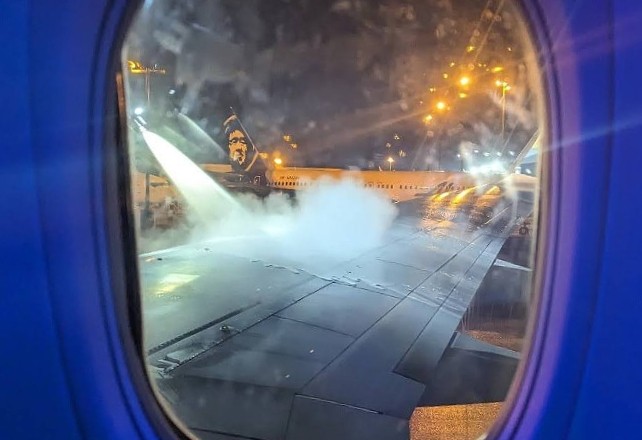
Those familiar with the Swedish science fiction film Aniara will not fail to connect it to the current developments on the quarantined cruise ship Diamond Princess, which is docked in a port not far from the most populous city on earth, Tokyo. The cruise ship had 3011 passengers, 621 of whom caught the deadly virus. Two of the Diamond Princess's passengers have died from coronavirus. They were old. In their 80s. And among the many who were indefinitely stuck and sick on the ship.
All of this for a moment sure looked like the bleak drama that unfolds on the sci-fi spaceship that's designed and operates like a cruise ship in Aniara. The movie's story: The spaceship, which is called Aniara and has the amenities of a cruise ship (shops, bars, recreation centers), is headed to Mars because Earth has become even less livable than that lifeless planet (please give some time to the digestion of that thought). All of a sudden, Aniara is knocked off course by space debris and begins to drift into a space that only becomes more and more space.
It's soon understood that there is no going back home. There is no hope for a rescue. But what are the humans on the ship to do with themselves in this pointless situation, this endless abeyance? Do they just live? Do they try to create meaning, and if so why? All one sees in the windows of the course-less spaceship Aniara is an emptiness that empties everything out of you.
Is this really the Diamond Princess? Not in a direct sense. But it does present a link between the coronavirus crisis and the current and ever-worsening climate catastrophe. The Earth itself is beginning to look like the spaceship Aniara. It is heading into the unknown of climate change. Is there hope for us? For sure, pretending like this can be fixed is the last thing we need. The most helpful point we can begin with at present is that we are truly fucked.
Watched the Swedish sci-fi Aniara last night and holy crap it's AMAZINGLY good. An incredibly bold space travel film perfectly executed. It's very much an Arthur C Clark story, in structure + with sci-fi concepts at play. One of the best indie sci-fi films since Arrival. #TIFF18 pic.twitter.com/0To396NAyO
— Alex Billington @ Berlinale (@firstshowing) September 14, 2018
Such acceptance is our only hope. And this is why the climate realism of the mycologist Nicholas Money is of such great importance. He knows, he says, he understands climate optimism is as much nonsense as climate denialism.
I reviewed Money's book The Amoeba in the Room: Lives of the Microbes in 2014. He is, in my opinion, a brilliant stylist, thinker, and biologist. While reading his thoughts on amoeba, or mushrooms, or yeast, one feels one is in the presence of a scientist whose approach to life is celebratory.
Here is Money on the intestinal bacteria that consume our bodies after they are dead:
I'm captivated by the revelation that my breakfast feeds the 100 trillion bacteria and archaea in my colon, and that they feed me with short-chain fatty acids… I'm thrilled by the fact that I am farmed by my microbes as much as I cultivate them, that bacteria modulate my physical and mental well-being, and that my microbes are programmed to eat me from the inside out as soon as my heart stops delivering oxygenated blood to my gut. My bacteria will die too, but only following a very fatty last supper.
The imagination can't help but see in these words a writer who loves life. And so it hit me as a surprise when Money emailed me a few days ago a short essay containing his thoughts on the current climate crisis. There was nothing in it but an unwavering realism. We are, according to Money, at the end of what was known and are entering an era that, by all indications, points to our extinction. To think otherwise is to live not in reality but the maddest of dreams.
Money writes:
Anyone who believes that Homo sapiens will adjust its course and halt the commerce that is founded on greenhouse gas emissions is refraining from critical thought. In 2019, Earth’s atmosphere was disfigured by the largest annual release of carbon dioxide from fossil fuels in history. This is alarming, but it is not surprising, because the human population rose by more than 80 million in the same period and global GDP swelled by 3 percent. The biosphere is warming because there are more lives that are cultivated by burning ever-increasing quantities of oil, natural gas, and coal. Besides our atmospheric vandalism, we continue to acidify the oceans and have proven relentless in the removal of forests and natural grasslands. In short order, we anticipate more extreme weather events, crop losses due to drought and flooding, and the collapse of fisheries. Populations of the larger wild animals will continue to fall, insect numbers will pursue their precipitous decline, plant species will perish, and the microbial majority of life will shudder unseen.Have you read any good news about the environment lately? I cannot think of a single joyful report about the biosphere in a very long time. And human prospects for survival are actually bleaker than most seem willing to admit. Let’s imagine that we devise a carbon capture system that reduces the level of greenhouse gases to the point that we cool off a little. What would happen next? Civilization would persevere, babies would keep coming, and the consumption of natural resources would accelerate. One way or another, we will destroy the components of the ecosystems that support life.
The path to extinction is difficult to avoid. I imagine that alien schoolchildren learn about the fate of civilizations once they begin burning their fossil fuels, or whatever similarly damaging inventions apply to other Goldilocks planets. There are steps in this process, comparable to the stages of cancer, from Stage One, when suspicious cells are confined, to Stage Four, where the illness has spread to other organs. As the late Christopher Hitchens wrote during his malady, “the thing about Stage Four is that there is no such thing as Stage Five.” As a species, we have been hovering around Stage Four for decades. “How long do the humans have left on Earth?” asks the schoolteacher on Planet Zeta, and noodly appendages are raised with enthusiasm across the classroom.
The end times will be horrific, but there is no sense denying their proximity. As paragons of consumption in the United States, our behavior gifts us with a great deal of material comfort. An objective look at the ecological cost-benefit of electric cars and solar panels shows that these are nothing more than funeral decorations for a dying planet. Nobody talks about population, but it is too late to thwart the apocalypse by contraception anyway. Few of us have any immediate plans to change our lifestyles.
One way or another we will have to confront the end times. There is no technological fix. Today’s opportunities for progress lie in psychiatry and philosophy. What sense do we make of our lives without a future for mankind? What sense can we make of a universe in which human consciousness will be extinct? Expressions of grace have always served us well in confronting our personal demise and their value may rise when we accept that civilization is approaching its expiration date. The focus on the grand carnival of nature is what’s different now. We may gain some personal sense of deliverance by looking squarely at the thing we have spoiled and admitting our fault. But the best that any of us can do until the sky falls is to be kinder to each other and humane towards the rest of life as it suffers with us on this watery globe. And who knows, if we are nicer, maybe things will keep running for longer than we expect.
Nicholas Money's latest book is The Selfish Ape: Human Nature and Our Path to Extinction. He discusses this new and important work and way of thinking through the climate crisis in this interview...
Listen to "The Fungi Factor – Nicholas P. Money, Professor, Miami University" on Spreaker.
Our last hope is not hope at all.
















